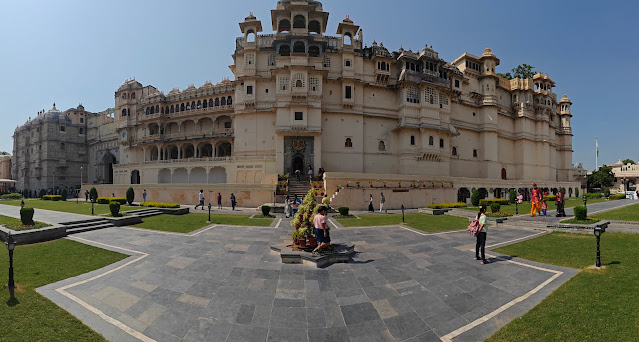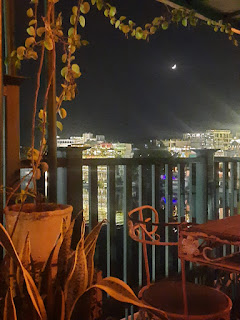Unveiling Udaipur's Crown Jewel: City Palace
Greetings, fellow wanderers! As we embark on our exploration of Rajasthan, allow me to regale you with my personal encounters and intriguing historical anecdotes centered around the remarkable Udaipur City Palace. This architectural marvel stands as an emblem of the city's glorious heritage and holds a paramount place in Udaipur's history. Nestled on the eastern shore of the picturesque Lake Pichola, the Udaipur City Palace offers a breathtaking vista of the lake's sparkling waters and the majestic Aravalli Mountains in the backdrop. It is not just a structure but a living testament to the opulence and grandeur of Rajasthan's royal legacy, which has captivated the imaginations of travelers from all corners of the globe. Join me as we delve into the rich history and cultural significance of the Udaipur City Palace, a true jewel in the crown of Udaipur's heritage.
 |
| Udaipur City Palace (pc: Abhijeet) |
Palace Highlights
Part of the City Palace has been converted into a museum that houses a rich collection of artifacts, royal clothing, armor, and other historical items. These displays vividly depict the lavish lifestyle and duties of the royals, providing a captivating window into their world. The imposing armors on display serve as powerful symbols of their strength and greatness.
 |
| pc: Abhijeet |
In the evenings, you have the opportunity to embark on a boat ride from Udaipur City Palace, offering a chance to explore the beauty of Lake Pichola and its serene surroundings. Regrettably, we had to forgo this enchanting experience due to time constraints.
Traveler's Top Tips
Plan your visit: Before my visit to Rajasthan, I held the belief that only people from my hometown, Pune, were known for their straightforward and sometimes sarcastic approach. However, my experience at the palace management shattered this perception. The staff there was incredibly unhelpful and unwilling to provide information. To spare yourself unnecessary frustration, it's advisable to research the palace's timings and other essential details online before your visit.
Regarding the guides: When exploring historical places and museums, obtaining essential information about the artifacts and exhibits enhances the experience significantly. But, I had reservations about the authenticity of the information provided by the guides at Rajasthan palaces. Many of these palaces offer audio guides as an alternative. Upon purchasing a ticket, you receive a set of headphones, and as you reach specific points marked for audio guidance, you can access important information about that spot. During our visit, we had children with us, making it challenging to focus on such guides. Hence, we decided not to opt for them. However, it might be a wise idea to research the audio guides and decide if they suit your preferences and circumstances before your visit.
Prepare for lengthy tour: When visiting the expansive palace, it's essential to recognize that it offers a wealth of attractions. If you have kids, whether they're young or grown, be mentally prepared to skip certain sections towards the end if their interest wanes. Alternatively, if that's not the case, ensure you allocate ample time (approximately half a day), take regular breaks, and bring supplies to stay hydrated and energized throughout your exploration.
City Tours in Rajasthan - A Word of Caution: When exploring cities in Rajasthan, including Udaipur, be wary of offers from hotels, auto-rickshaw drivers, and taxi drivers who propose day tours or half-day tours costing 1000-2000 rupees. It's important to note that if your accommodation is centrally located, many attractions are within walking distance. Furthermore, some places are inaccessible by cab.
Additionally, consider your travel preferences – if you'd rather savor a few experiences instead of rushing through numerous palaces, lakes, and gardens, you may not need to visit every spot on their lists. Instead, conduct some research, choose a select few places of interest, plan your itinerary according to their opening hours and proximity (using Google or recommendations from locals), and you'll have a fulfilling experience without unnecessary temptations.
The provided write-up should equip you adequately for your upcoming visit. However, if you're keen on delving into some fascinating historical context, read on. Personally, I find that having some background knowledge enhances my connection with the historical artifacts and surroundings, making the visit all the more enriching.
Historical Insights
Maharana Udai Singh II was a prominent ruler of the Mewar dynasty in Rajasthan that is believed to have been founded in the 6th century by Bappa Rawal, a legendary warrior and chief of the Guhilot clan of Rajputs. The Mewar lineage produced notable leaders, such as Maharana Pratap, Udai Singh II's son. Maharana Pratap is celebrated for his legendary valor and unwavering resistance against the Mughal Emperor Akbar in the 16th century, symbolizing his dedication to preserving Mewar's independence. The Mewar rulers staunchly defended their sovereignty, fiercely resisting external powers, including the Mughals.
Maharana Udai Singh II's decision to relocate the Mewar kingdom's capital stemmed from the vulnerability of the previous capital, Chittorgarh, which had endured repeated sieges. Udaipur was strategically chosen due to its natural defenses, nestled among hills and lakes.
The construction of the City Palace was a response to the need for a fortified complex to safeguard the ruling dynasty from external threats, including incursions by rival Rajput kingdoms and the Mughals. The City Palace became the epicenter of administrative and political affairs in the region. It housed the Mewar kingdom's administrative offices and facilitated effective governance by allowing rulers to oversee their territories with ease.
Udaipur City Palace played a pivotal role in Mewar's history, witnessing significant events and battles, thus solidifying its historical importance in the region.



.jpeg)
Comments
Post a Comment